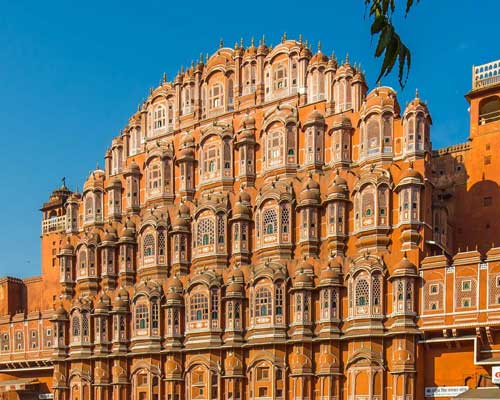Jaipur, the capital of Rajasthan, is a city that enthralls visitors with its magnificent forts, opulent palaces, and vibrant culture. Known as the “Pink City” due to the distinctive pink-hued buildings in its old city, Jaipur is a key part of India’s Golden Triangle tourist circuit. Here are the top eight places you must visit in Jaipur to experience its royal charm and historical grandeur.
1. Amber Fort (Amer Fort)
Perched majestically on a hill overlooking Maota Lake, the Amber Fort is a UNESCO World Heritage Site and one of Jaipur’s most iconic attractions. This splendid fortress, built with red sandstone and marble, is a beautiful fusion of Mughal and Rajput architecture. The main attractions within the fort include the Diwan-i-Aam (Hall of Public Audience), the Diwan-i-Khas (Hall of Private Audience), the Sheesh Mahal (Palace of Mirrors), and the Sukh Niwas. You can take a jeep or an elephant ride up the hill to the fort’s entrance, and in the evening, don’t miss the captivating Sound and Light Show that narrates the fort’s history.
2. Hawa Mahal (Palace of Winds)
A five-story, honeycomb-shaped structure, the Hawa Mahal is arguably the most photographed landmark in Jaipur. Built in 1799, its unique facade with 953 intricate jharokhas (windows) was designed to allow royal women to observe daily life and processions on the street below without being seen. The Hawa Mahal’s design allows for a natural cooling breeze to flow through the palace, giving it its name, the “Palace of Winds.” While the exterior is a sight to behold, you can also go inside to see the various floors and get a different perspective.
3. City Palace
Located in the heart of the old city, the City Palace is a sprawling complex that beautifully blends Rajput, Mughal, and European architectural styles. It continues to be the residence of the Jaipur royal family, with a private section still in use. The palace complex houses several courtyards, gardens, and buildings, including the Mubarak Mahal (Palace of Welcome), which now serves as a museum displaying royal costumes, and the Chandra Mahal, the residence of the current Maharaja. The Pitam Niwas Chowk, with its four exquisitely painted gates representing different seasons, is a highlight.
4. Jantar Mantar
Adjacent to the City Palace, Jantar Mantar is an astronomical observatory and a UNESCO World Heritage Site. Built by Maharaja Sawai Jai Singh II in the 18th century, it features a collection of 19 large-scale stone instruments that were used for astronomical observations. The most impressive instrument is the Samrat Yantra, the world’s largest stone sundial, which can measure time with incredible accuracy. This site is a fascinating testament to the scientific and architectural ingenuity of the era.
5. Nahargarh Fort
Perched on the Aravalli Hills, Nahargarh Fort offers a breathtaking panoramic view of Jaipur city. It was built as a defensive ring for the city and was also used as a hunting retreat for the royal family. While the fort has a rugged, military feel, it also contains the beautiful Madhavendra Bhawan, a palace with a series of identical suites for the king’s queens. Nahargarh Fort is particularly popular for its stunning sunset views over the city, making it a perfect spot for an evening visit.
6. Jaigarh Fort
Often referred to as the “Victory Fort,” Jaigarh Fort is located on the “Cheel ka Teela” (Hill of Eagles) and was built to protect the Amber Fort. This military structure is known for its well-preserved fortifications and has never been captured. Its main attraction is the Jaivana Cannon, which was once the world’s largest cannon on wheels. A visit to Jaigarh Fort provides a glimpse into the military prowess of the Rajputs and offers commanding views of the surrounding landscape.
7. Jal Mahal (Water Palace)
Located in the middle of the Man Sagar Lake, the Jal Mahal is a serene and beautiful palace that appears to float on the water’s surface. This architectural marvel was once a hunting lodge for the Maharajas. While visitors cannot enter the palace, its picturesque setting and the surrounding Aravalli hills make for a stunning photo opportunity. The best time to view the Jal Mahal is during sunrise or sunset when the soft light illuminates its beautiful red sandstone structure.
8. Albert Hall Museum
Situated in the Ram Niwas Garden, the Albert Hall Museum is the oldest museum in Rajasthan. This Indo-Saracenic architectural masterpiece was designed by Sir Samuel Swinton Jacob and resembles the Victoria and Albert Museum in London. The museum houses a vast collection of artifacts, including miniature paintings, pottery, sculptures, and an Egyptian mummy. The building itself is a work of art, and it is beautifully illuminated at night, making it a spectacular sight to behold.
